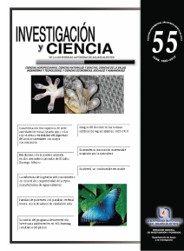Physicochemical characterization of seven red-purple prickly pear fruit varieties (Opuntia spp.) and pigment stability of two varieties with the highest concentration
DOI:
https://doi.org/10.33064/iycuaa2012554049Keywords:
prickly pear varieties grown in Mexico, Opuntia spp., physicochemical characterization, prickly pear fruit, betalains stability, natural pigmentsAbstract
Physico-chemical characteristics were evaluated from the fruit of seven prickly pear (Opuntia spp.) varieties grown in Mexico and the pigment stability from two of them was monitored for 91 days under storage at three pH levels and two temperatures. Value ranges were recorded from the water content variables (81.34-85.29 g 100 g-1 fresh weigh (FW)), ash (0.48-0.57 g 100 g-1 FW), protein (0.20-0.39 g 100 g-1 FW), fat (0.13-0.83 g 100 g-1 FW), crude fiber (0.33-0.72 g 100 g-1 FW), total soluble solids (9.67-14.12 ºBrix), citric acid (0.020-0.074 g 100 g-1 FW) and pH (3.32-5.81). Pigment concentration varied widely between varieties, with Pintadera having the highest (86.69 mg betanina 100 g-1 FW), followed by Tapón Aguanoso (58.12 mg betanina 100 g-1 FW).
Downloads
References
• Acree, T.E.; Lee, C.Y.; Butts, R.M.; Barnard, J., Geosmin, the earthy component of table beet odor. Journal of Agricultural and Food Chemistry, 24: 430-431, 1976.
• AOAC, Official Methods of Analysis. 15th, U.S.A.: Association of Official Analytical Chemists. 1990.
• BARBERA, G.; INGLESE, P.; LA MANTIA, T., Seed content and fruit characteristics in cactus pear (Opuntia ficus-indica (L.) Miller). Sciencia Horticulturae, 58: 161-165, 1994.
• CASTELLANOS SANTIAGO, E.; YAHIA, E.M., Identification and quantification of betalains from the fruits of 10 mexican prickly pear cultivars by high-performance liquid chromatography and electrospray ionization mass spectrometry. Journal of Agricultural and Food Chemistry, 56: 5758-5764, 2008.
• CASTELLAR, M.R.; OBÓN, J.M.; ALACID, M.; FERNÁNDEZ LÓPEZ, J.A., Color properties and stability of betacyanins from Opuntia fruits. Journal of Agricultural and Food Chemistry, 51: 2772-2776, 2003.
• CASTELLAR, M.R.; OBÓN, J.M.; ALACID, M.; FERNÁNDEZ LÓPEZ, J.A., The isolation and properties of a concentrated red-purple betacyanin food colourant from Opuntia stricta fruits. Journal of the Science of Food and Agriculture, 86(1): 122-128, 2006.
• FERNÁNDEZ LÓPEZ, J.A.; ALMELA, L., Application of high-performance liquid chromatography to the characterization of the betalain pigments in prickly pear fruits. Journal of Chromatography A., 913 (1-2): 415-420, 2001.
• FORNI E.; POLESTELLO A.; MONTEFIORI D.; MAESTRELLI, A., High-performance liquid chromatographic analysis of the pigments of blood-red prickly pear (Opuntia ficus indica). Journal of Chromatography A., 593(1-2): 177-183, 1992.
• GUERRERO, M.P.; ZAVALETA, M.H.A.; BARRIENTOS, P.A.F.; GALLEGOS, V.C.; NÚÑEZ, C.C.A.; VALADEZ, M.E.; CUEVAS, S.J.A., Técnica para el estudio de la micromorfología interna de semillas duras en Opuntia. Revista Fitotecnia Mexicana, 29(2): 37-43, 2006.
• HERBACH, K.M.; STINTZING, F.C.; CARLE, R., Betalain stability and degradation-structural and chromatic aspect. Journal of Food Science, 71(4): 41-49, 2006.
• Hernández Pérez, T., Carrillo López, A., Guevara Lara, F., Cruz Hernández, A.; Paredes López, O., Biochemical and nutritional characterization of three prickly pear species with different ripening behavior. Plant Foods for Human Nutrition, 60(4): 195-200, 2005.
• INGLESE, P.; BARBERA, G.; LA MANTIA, T.; PORTOLANO, S., Crop production and ultimate size of cactus fruit following fruit thinning. HortScience, 30: 227-230, 1995.
• KUTI, J.O.; GALLOWAY, C.M., Sugar composition and invertase activity in prickly pear fruit. Journal of Food Science, 59(2): 387-388, 1994.
• MARTÍNEZ, F.R., Monografía de nopal tunero. México: Secretaría de Desarrollo Rural del Estado de Puebla, 2007.
• Minolta Corporation Manual. Precise color communication. Ramsey, NJ: Minolta Corporation Instrument System Division, 1994.
• Pelayo Zaldívar, C.; Castillo Ánimas, D.; Chatelain Mercado, S.; Siade Barquet, G., Manejo poscosecha de la nochitli o tuna (Opuntia spp.). México: Universidad Autónoma Metropolitana-Iztapalapa, 2010.
• PIGA, A., Cactus pear: a fruit of nutraceutical and functional importance. Journal of the Professional Association for Cactus Development, 6: 9-20, 2004.
• REYNOSO, R.; GARCÍA, F.A.; MORALES, D.; GONZÁLEZ DE MEJIA, E., Stability of Betalain Pigments from a Cactaceae Fruit. Journal of Agricultural and Food Chemistry. 45(8): 2884-2889, 1997.
• SÁENZ, C., Processing technologies: an alternative forcactus pear (Opuntia spp.) fruits and cladodes. Journal of Arid Environments. 46(3): 209-225, 2000.
• SÁENZ, C.; SEPÚLVEDA, E., Cactus-pear juices. Journal of the Professional Association for Cactus Development, 4(3-10), 2001.
• SAPERS, G.M.; HORNSTEIN, J.S., Varietal differences in colorant properties and stability of red beet pigments. Journal of Food Science. 44(4): 1245-1248, 1979.
• SAWAYA, W.N.; KHATCHADOURIAN, H.A.; SAFI, W.M.; AL-MUHAMMAD, Chemical characterization of prickly pear pulp, Opuntia ficus-indica, and the manufacturing of prickly pear jam. International Journal of Food Science & Technology, 18(2): 183-193, 1983.
• SEPÚLVEDA, E., Cactus pear fruit potential for industrialization. In: Sáenz C, editor. Proceedings of the International Symposium: cactus pear and nopalitos processing and uses (pp. 17-21). Santiago, Chile, 1998.
• STINTZING, F.C.; HERBACH, K.M.; MOßHAMMER, M.R.; CARLE, R.; YI, W.E., SELLAPPAN, S.; AKOH, C.C.; BUNCH, R.; FELKER, P., Color, betalain pattern and antioxidant properties of cactus pear (Opuntia sp.) clones. Journal of Agricultural and Food Chemistry, 53(2): 442-451, 2005.
• STINTZING, F.C.; SCHIEBER, A.; Carle, R., Phytochemical and nutritional significance of cactus pear. European Food Research and Technology. 212(4): 396-407, 2001.
• STRACK, D.; VOGT, T.; SCHLIEMANN, W., Recent advances in betalain research. Phytochemistry. 62(3): 247-269, 2003.
• VILORIA MATOS, A.; CORBELLI-MORENO, D.; MORENO ÁLVAREZ, M.J.; BELEN C., Stability in betalains from tuna pulp (Opuntia boldinghii Br. et R.) submitted to a lyophilization process. Revista de la Facultad de Agronomía, 19: 324-331, 2002.
• WYBRANIEC, S.; PLATZNER, I.; GERESH, S., GOTTLIEB, H.E.; HAIMBERG, M.; MOGILNITZKI, M.; MIZRAHI, Y., Betacyanins from vine cactus Hylocereus polyrhizus. Phytochemistry, 58(8): 1209-1212, 2001.
Downloads
Published
How to Cite
License
Copyright (c) 2012 Elia Nora Aquino Bolaños, Yazmín Chavarría Moctezuma, José Luis Chávez Servia, Rosa Isela Guzmán Gerónimo, Eryck R. Silva Hernández, Iñigo Verdalet Guzmán

This work is licensed under a Creative Commons Attribution-NonCommercial-ShareAlike 4.0 International License.
Las obras publicadas en versión electrónica de la revista están bajo la licencia Creative Commons Atribución-NoComercial-CompartirIgual 4.0 Internacional (CC BY-NC-SA 4.0)









